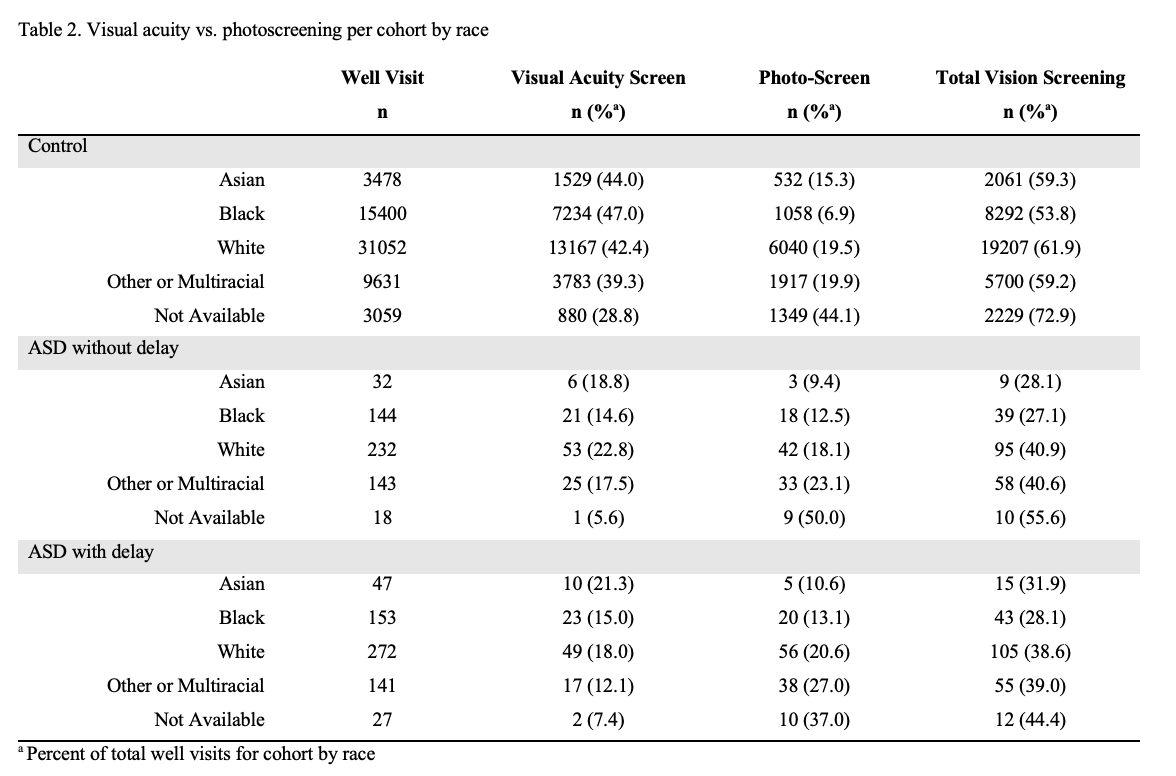Back
General Pediatrics: Primary Care/Prevention
Category: Abstract Submission
General Pediatrics IV
181 - Disparities in Vision Screening in Primary Care for Young Children with Autism Spectrum Disorder
Sunday, April 24, 2022
3:30 PM – 6:00 PM US MT
Poster Number: 181
Publication Number: 181.317
Publication Number: 181.317
Kimberly Hoover, Sidney Kimmel Medical College - - Philadelphia, PA, medford, NJ, United States; MATTHEW D. DI GUGLIELMO, Sidney Kimmel Medical College at Thomas Jefferson University, WILMINGTON, DE, United States; Brittany Perry, Nemours Children's Hospital, Wilmington, DE, United States

Kimberly Hoover
Medical Student
Sidney Kimmel Medical College - - Philadelphia, PA
Medford, New Jersey, United States
Presenting Author(s)
Background: Autism spectrum disorder (ASD) places children at higher risk for vision problems. Prior studies have demonstrated numerous health disparities for individuals with ASD, including delays of vision screening. Early screening and appropriate referral to eye care specialists are vital. Photoscreening may be useful in increasing rates of early screening.
Objective: Analyze the (1) rate of vision screening among children with and without ASD, (2) rate of photo-screening compared to visual acuity screening, (3) effect of race and ethnicity on vision screening for children with ASD.
Design/Methods: Data from well visits for 3- to 5-year-olds between January 2016 and December 2019 were collected via PEDSnet. Visits were classified based on patient diagnosis: (1) ASD with developmental delay, (2) ASD without developmental delay, and (3) no ASD. Billing codes for vision screening were markers of completion of vision screening. Chi square analysis examined the (1) relationship of race and ethnicity to vision screening rate and (2) rate of photoscreening versus visual acuity screening. Multivariate logistic regression assessed factors that impacted odds of vision screening.
Results: Children with ASD were less likely to have a vision screening (36.5%) compared to children without ASD (59.9%). The lowest rates of screening occurred during the 3-year visit across all subgroups (Table 1). Black children with ASD had a significantly lower screening rate (27.6%) than both white children (39.7%) and other/multiracial children with ASD (39.8%) (Table 2). Use of photoscreening was higher in Hispanic children than in non-Hispanic children for all groups and increased the overall rate of vision screening in Hispanic children above non-Hispanic children (Table 3). Factors that decreased odds of visual acuity screening included: autism, Asian race, public insurance, and Florida location. Factors that decreased odds of photoscreening included: autism, Black or African American race, Puerto Rican or Mexican/Chicanx ethnicity, and public insurance.Conclusion(s): Children with ASD are significantly less likely to receive vision screening at well visits compared to typically developing children. Rate of screening increased with patient age. Black children with ASD had the lowest rate of screening. Instrument-based screening is a useful tool to decrease disparity, especially among younger patients or Hispanic patients. Increased awareness of factors that reduce the likelihood of vision screening in children with autism may improve care of this patient population.
CV Hoover, KimberlyHoover, Kimberly - CV.pdf
Table 2. Visual acuity vs. photoscreening per cohort by race Among all children with ASD, there was a significantly lower rate of screening among black children (27.6%) when compared to both white children (39.7%, 𝜒2 [1, N = 801] = 11.941, p < 0.01) and children classified as other or multiracial (39.8%, 𝜒2 [1, N = 581] = 9.66, p < 0.01).
Among all children with ASD, there was a significantly lower rate of screening among black children (27.6%) when compared to both white children (39.7%, 𝜒2 [1, N = 801] = 11.941, p < 0.01) and children classified as other or multiracial (39.8%, 𝜒2 [1, N = 581] = 9.66, p < 0.01).
Objective: Analyze the (1) rate of vision screening among children with and without ASD, (2) rate of photo-screening compared to visual acuity screening, (3) effect of race and ethnicity on vision screening for children with ASD.
Design/Methods: Data from well visits for 3- to 5-year-olds between January 2016 and December 2019 were collected via PEDSnet. Visits were classified based on patient diagnosis: (1) ASD with developmental delay, (2) ASD without developmental delay, and (3) no ASD. Billing codes for vision screening were markers of completion of vision screening. Chi square analysis examined the (1) relationship of race and ethnicity to vision screening rate and (2) rate of photoscreening versus visual acuity screening. Multivariate logistic regression assessed factors that impacted odds of vision screening.
Results: Children with ASD were less likely to have a vision screening (36.5%) compared to children without ASD (59.9%). The lowest rates of screening occurred during the 3-year visit across all subgroups (Table 1). Black children with ASD had a significantly lower screening rate (27.6%) than both white children (39.7%) and other/multiracial children with ASD (39.8%) (Table 2). Use of photoscreening was higher in Hispanic children than in non-Hispanic children for all groups and increased the overall rate of vision screening in Hispanic children above non-Hispanic children (Table 3). Factors that decreased odds of visual acuity screening included: autism, Asian race, public insurance, and Florida location. Factors that decreased odds of photoscreening included: autism, Black or African American race, Puerto Rican or Mexican/Chicanx ethnicity, and public insurance.Conclusion(s): Children with ASD are significantly less likely to receive vision screening at well visits compared to typically developing children. Rate of screening increased with patient age. Black children with ASD had the lowest rate of screening. Instrument-based screening is a useful tool to decrease disparity, especially among younger patients or Hispanic patients. Increased awareness of factors that reduce the likelihood of vision screening in children with autism may improve care of this patient population.
CV Hoover, KimberlyHoover, Kimberly - CV.pdf
Table 2. Visual acuity vs. photoscreening per cohort by race
 Among all children with ASD, there was a significantly lower rate of screening among black children (27.6%) when compared to both white children (39.7%, 𝜒2 [1, N = 801] = 11.941, p < 0.01) and children classified as other or multiracial (39.8%, 𝜒2 [1, N = 581] = 9.66, p < 0.01).
Among all children with ASD, there was a significantly lower rate of screening among black children (27.6%) when compared to both white children (39.7%, 𝜒2 [1, N = 801] = 11.941, p < 0.01) and children classified as other or multiracial (39.8%, 𝜒2 [1, N = 581] = 9.66, p < 0.01).